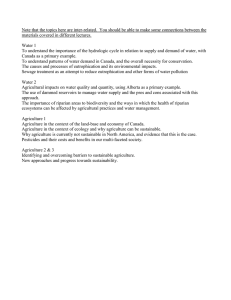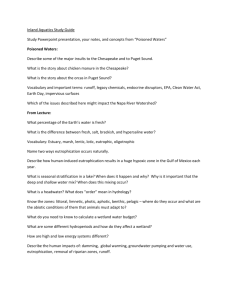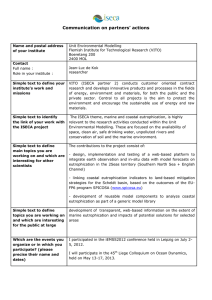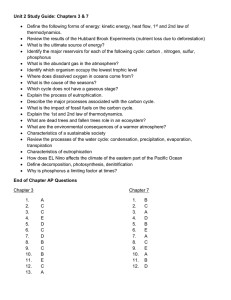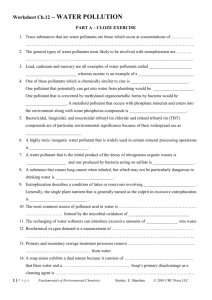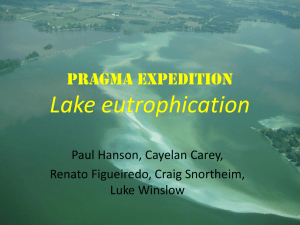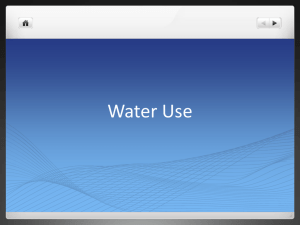native rendition
advertisement
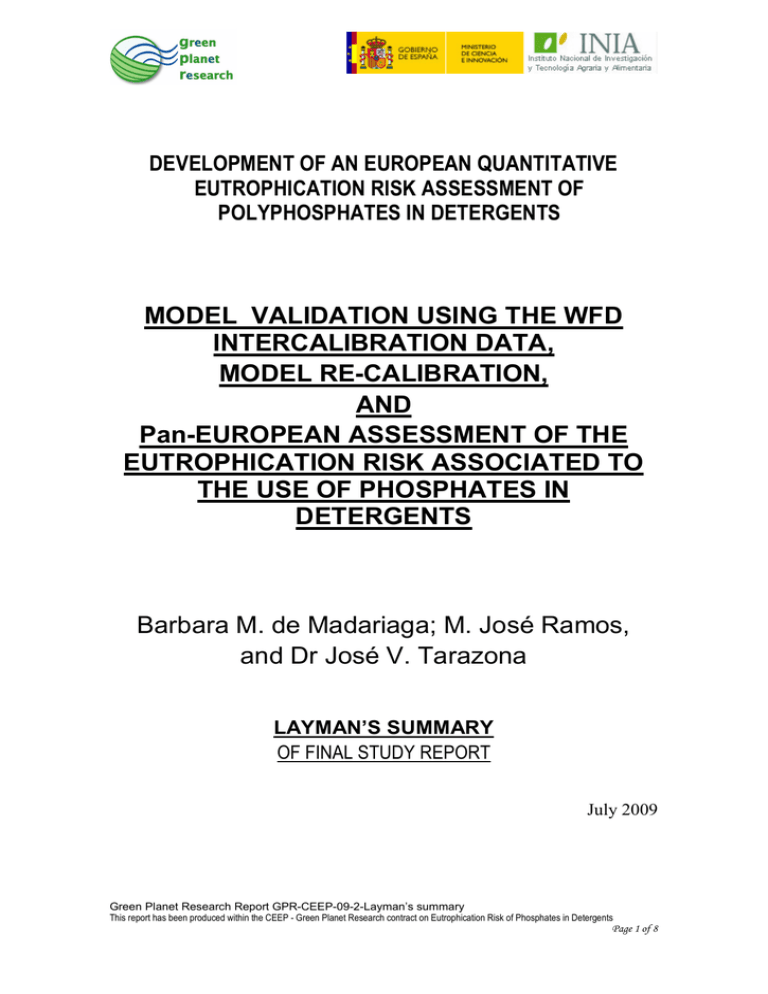
DEVELOPMENT OF AN EUROPEAN QUANTITATIVE EUTROPHICATION RISK ASSESSMENT OF POLYPHOSPHATES IN DETERGENTS MODEL VALIDATION USING THE WFD INTERCALIBRATION DATA, MODEL RE-CALIBRATION, AND Pan-EUROPEAN ASSESSMENT OF THE EUTROPHICATION RISK ASSOCIATED TO THE USE OF PHOSPHATES IN DETERGENTS Barbara M. de Madariaga; M. José Ramos, and Dr José V. Tarazona LAYMAN’S SUMMARY OF FINAL STUDY REPORT July 2009 Green Planet Research Report GPR-CEEP-09-2-Layman’s summary This report has been produced within the CEEP - Green Planet Research contract on Eutrophication Risk of Phosphates in Detergents Page 1 of 8 LAYMAN’S SUMMARY of final study report This is a simplified summary of the final report of the study entitled: MODEL VALIDATION USING THE WFD INTERCALIBRATION DATA, MODEL RE-CALIBRATION, AND PanEUROPEAN ASSESSMENT OF THE EUTROPHICATION RISK ASSOCIATED TO THE USE OF PHOSPHATES IN DETERGENTS conducted as a follow up of the previous study “Development of an European Quantitative Eutrophication Risk Assessment of Phosphates in Detergents” carried out by Green Planet Research and INIA (Spanish National Institute for Agricultural and Food Research and Technology) for CEEP, a Cefic sector group (European detergent phosphate industry joint research association) in the context of the EU Detergent Regulation. The full study report is available at the European Commission web page: http://ec.europa.eu/enterprise/chemicals/legislation/detergents/index_en.htm Study Background Polyphosphates are widely used in laundry and dishwasher detergents as “builders”. In conjunction with surfactants, they allow detergents to perform efficiently in all washing conditions. The voluntarily programme “HERA” assessed the potential environmental and human risks of these substances and concluded that they are of no toxicological concern. Nevertheless, the use of polyphosphates in detergents contributes to the total release of phosphorous, a nutrient for algae and microorganisms, via municipal sewers and wastewater treatment plants. High phosphorous concentrations may provoke accelerated growth of algae and aquatic plants with undesirable disturbance to the balance of organisms and the quality of the water, a phenomenon called “eutrophication”. In the previous study, published in 2007, a new method was developed for quantifying the contribution of polyphosphates in detergents to the overall eutrophication risk. The model was submitted to the European Union Scientific Committee on Health and Environmental Risks (SCHER). SCHER considered that the developed model represented a novel tool to assess, in a quantitative manner, the risks of eutrophication due to phosphorus release. The concept and its application to eutrophication phenomena were considered to be innovative and – within the limitations given by the authors – to be scientifically valid. However, SCHER was of the opinion that the overall quality of the study was diminished by the restricted data base used to develop the model and other limitations which, in fact, had been already mentioned by the study authors in their report; and suggested that the science presented in the report should be further developed based on available data not submitted previously due to confidentially issues. This report describes the validation and re-calibration exercise, conducted as a follow up of the SCHER opinion. Objectives The study was conducted for addressing the comments and recommendations of SCHER. The objective of the study was to validate, with expert peer review of the methodology, a (quantitative) risk assessment model for eutrophication, allowing the comparative assessment of different sources of phosphates and, to calculate the contribution from Phosphorus-based detergents (P-based detergents). Green Planet Research Report GPR-CEEP-09-2-Layman’s summary This report has been produced within the CEEP - Green Planet Research contract on Eutrophication Risk of Phosphates in Detergents Page 2 of 8 Due to expected differences in the sensibility of water bodies in different areas and with different typologies, the assessment included different ecoregions around Europe and different ecotypes within each ecoregion. Methodology The validation was conducted using the set of data provided by the Joint Research Centre (JRC) of the European Commission, collected for the Inter-Calibration exercise under the Water Framework Directive. The use of this database was recommended by the SCHER, and DG Enterprise facilitated the contact with the JRC, who then kindly provided the data in a codified form in order to maintain site confidentially. As observed in Table 1, the number of data points for the Mediterranean ecoregion was too limited for a proper assessment. Therefore, after a comparative statistical analysis of the databases, the JRC and the INIA-Green Planet sets of data were combined for the re-calibration exercise, producing new effect estimation (risk-response) curves which were used in the final risk estimations. Table 1. Summary description of the JRC and INIA Databases Ecoregion Status No. Total No. Good No. Less than good Ecoregion No. Total No. Good No. Less than good JRC IC-WFD Database Northern Central/Baltic Atlantic Mediterranean Chlor a Macrophytes Chlor a Chlor a Chlor a 484 769 990 44 34 402 516 549 19 31 82 253 441 25 3 INIA-Green Planet Database Northern/Central/Atlantic Mediterranean 185 75 83 37 102 38 Due to the complexity of the eutrophication phenomena, the estimations are based on probability approaches. The principles defined under the Water Framework Directive, were used in this development. The Directive establishes the criteria that water bodies must fulfil for considering that they are in good condition regarding their eutrophication status; if the criteria are not fulfilled the water body should be considered in fair, poor or bad eutrophication conditions, or using general terms, in less-than-good conditions. The study used this approach for establishing a quantitative eutrophication risk estimator. For each Total Phosphorous concentration (TP), the eutrophication risk was defined as the likelihood of a sensitive site, susceptible to eutrophication, to be in less-than-good eutrophication status. The eutrophication risk is expressed as a relative value, ranging from 0 to 1 (or 0% to 100% when expressed as percentage). The correction is associated to the maximum expected value, and therefore, it is related to the likelihood expected when the percentage of sites in less than good eutrophication status reach the maximum value for each TP level. TP is a continuous variable, and all probability distributions are presented as cumulative distributions; therefore, for a certain TP value “x” the associated risk “y” must be understood as following: if the TP concentration value does not exceed x (TP ≤ x) the expected eutrophication risk will not exceed y (Eutrophication risk ≤ y). Green Planet Research Report GPR-CEEP-09-2-Layman’s summary This report has been produced within the CEEP - Green Planet Research contract on Eutrophication Risk of Phosphates in Detergents Page 3 of 8 Results Unfortunately, the available information did not allow to estimate a single value for each point in the eutrophication risk/concentration value curve. However, the maximum and minimum possible values of the eutrophication risk could be obtained. The field data were distributed in the two main categories, water bodies fulfilling the good status conditions, or “G+”; and those with less than good status, or “G-“. Probability distributions of the TP concentrations in each of the two groups “G+” and “G-“ were estimated. The obtained distributions are called the conditional probability distributions p(TP | G+) and p(TP | G-). The conditional probability is the probability of some event A occurring, given that some other event B is known to have occurred. In this case, p(TP | G+) represents the probability of a water body having a certain total phosphorus concentration, TP, given that the water body is in good status conditions, G+. Similarly, p(TP | G-) represents the probability of a water body having a certain total phosphorus concentration, TP, given that the water body is not in good status conditions, G-. These distributions represent the maximum and minimum potential value of the eutrophication risk; therefore, the risk estimator is presented as a range, defined by both conditional distributions. Figure 1 presents, as example, the results obtained for the Central/Baltic Ecoregion. 100% 90% 80% Eutrophication risk 70% 60% 50% 40% 30% 20% 10% 0% 1 100 Total P Annual Average Figure 1. Eutrophication risk/concentration responses for the Central/Baltic ecoregion. The shadow area represents the risk range for each TP concentration. For example, the risk associated to a TP concentration of 100 µg P/l could be any value between 66 and 96% (blue line). As expected, significant differences among different European ecoregions were observed. The data base allowed estimations for four main regions: Northern, Central/Baltic, Atlantic and Mediterranean. The final distributions are presented in Figure 2. The distributions are presented by the upper (symbol +) and the lower (symbol ◊) lines; the colour lines represents the estimations for each ecoregion; the black lines represents the estimations for the whole data base. Additional significant differences were observed among ecotypes in the Northern and Central/Baltic ecoregions. The results can be found in the full report. Green Planet Research Report GPR-CEEP-09-2-Layman’s summary This report has been produced within the CEEP - Green Planet Research contract on Eutrophication Risk of Phosphates in Detergents Page 4 of 8 1 0,9 0,8 0,8 0,7 0,7 Eutrophication risk Eutrophication risk 1 0,9 0,6 0,5 0,4 0,6 0,5 0,4 0,3 0,3 0,2 0,2 0,1 0,1 0 0 1 100 1 100 Total P Annual Average INIA JRC G- INIAJRC NORTH G+ INIAJRC NORTH G- INIA JRC G+ 1 1 0,9 0,9 0,8 0,8 0,7 0,7 Eutrophication risk Eutrophication risk INIA JRC G+ Total P Annual Average 0,6 0,5 0,4 INIAJRC ATL G+ INIAJRC ATL G- 0,6 0,5 0,4 0,3 0,3 0,2 0,2 0,1 0,1 0 INIA JRC G- 0 1 100 1 100 Total P Annual Average INIA JRC G+ INIA JRC G- INIAJRC CB G+ Total P Annual Average INIAJRC CB G- INIA JRC G+ INIA JRC G- INIAJRC MED G+ INIAJRC MED G- Figure 2. Proposed eutrophication risk/concentration responses for the four selected ecoregions and its comparison with the overall distribution. Comparative risk assessment Due to the complexity of the proposed methodology a specific expert consultation was conducted to obtain information on the understanding, comprehension, perception and preferences of different alternatives for presenting the results. The preferences from the experts were for receiving as much information as possible on the risk characterization output and its associated uncertainty. Estimated risk contributions from laundry and dishwashing detergents The updated (2007) information on P-based detergent consumption provided by the European detergent industry association (AISE) included information on laundry and dishwasher detergents. Therefore, the risk communication options were adapted in order to present information on the contribution of each type of detergent and for the combination of phosphorous emissions associated to both kinds of detergents. Two complementary methods were used for the estimation. A deterministic approach was based on averaged conditions for each ecoregion. A probabilistic approach based on Monte Carlo analysis covered the whole variability expected for each ecoregion and ecotype. In the deterministic approach the risk is presented by graphs comparing the different risk estimations. The results are summarised in the following figures. The deterministic estimations were conducted for average European values at three phosphorous concentration levels. The results for the lowest selected concentration, which represents the highest estimated detergents` contribution for each ecoregion, are shown in Figures 3 to 6. Green Planet Research Report GPR-CEEP-09-2-Layman’s summary This report has been produced within the CEEP - Green Planet Research contract on Eutrophication Risk of Phosphates in Detergents Page 5 of 8 Each figure presents five blue vertical lines, representing the values among which the eutrophication risk is expected to range for each assessed scenario. The five scenarios are: • TOTAL: Overall actual risk estimated for the sum of all current phosphorous emissions • Risk without laundry detergents (expected risk if P-based laundry detergents are not used). • Risk without dishwashing detergents (as above but for P-based dishwashing detergents). • Risk without L&B detergents (expected risk if both types of P-based detergents are not used). • Risk without point sources (expected risk if all domestic emissions, including human metabolism and detergents, are removed). 100 EUTROPHICATION RISK 90 80 70 60 50 40 30 20 10 0 TOTAL Risk without laundry detergents Risk without dishwashing detergents Risk without L&D detergents Risk without point sources the line represents the range Figure 3. Graphic representation of the contribution of P-based detergents to the eutrophication risk estimated for the Atlantic ecoregion using averaged values and a TP concentration of 50 µgP/l. 100 EUTROPHICATION RISK 90 80 70 60 50 40 30 20 10 0 TOTAL Risk without laundry detergents Risk without dishwashing detergents Risk without L&D detergents Risk without point sources the line represents the range Figure 4. Graphic representation of the contribution of P-based detergents to the eutrophication risk estimated for the Central/Baltic ecoregion using averaged values and a TP concentration of 50 µgP/l. Green Planet Research Report GPR-CEEP-09-2-Layman’s summary This report has been produced within the CEEP - Green Planet Research contract on Eutrophication Risk of Phosphates in Detergents Page 6 of 8 100 EUTROPHICATION RISK 90 80 70 60 50 40 30 20 10 0 TOTAL Risk without laundry detergents Risk without dishwashing detergents Risk without L&D detergents Risk without point sources the line represents the range Figure 5. Graphic representation of the contribution of P-based detergents to the eutrophication risk estimated for the Northern ecoregion using averaged values and a TP concentration of 50 µgP/l. 100 EUTROPHICATION RISK 90 80 70 60 50 40 30 20 10 0 TOTAL Risk without laundry detergents Risk without dishwashing detergents Risk without L&D detergents Risk without point sources the line represents the range Figure 6. Graphic representation of the contribution of P-based detergents to the eutrophication risk estimated for the Mediterranean ecoregion using averaged values and a TP concentration of 50 µgP/l. Complementary results were obtained through the probabilistic assessments conducted for each ecoregion. The outcome of the estimations conducted for the concentration-risk curves obtained for the whole ecoregion using the chlorophyll a boundaries for establishing the ecological status were used as reference values for the comparison. Minor differences were observed when using the available alternative concentration-risk curves: the ecotype specific curves for the Central/Baltic and Northern ecoregions and the curve obtained using the macrophytes boundary for the Northern ecoregion. These differences do not modify the proposed conclusions. Green Planet Research Report GPR-CEEP-09-2-Layman’s summary This report has been produced within the CEEP - Green Planet Research contract on Eutrophication Risk of Phosphates in Detergents Page 7 of 8 A summary of the results obtained using both approaches: a) maximum risk contribution obtained using deterministic methods and average conditions; and b) Most likely values (10 to 90th percentiles) of the overall range obtained by Monte Carlo analysis are presented in Table 2. Table 2. Results obtained for the different generic scenarios. The table shows the difference between the total risk and the risk without P-based detergents estimated using the deterministic and probabilistic methods . (This difference is presented for the upper and lower bounds of the risk range). Ecoregion Risk contribution from Risk contribution from detergents detergents th Deterministic value for 10 to 90 percentile for the averaged conditions probabilistic approach Laundry Dishwash Both Laundry Dishwash Both Atlantic Central/Baltic Northern Mediterranean % 0.7-1.8 3.0-3.1 0.0-3.2 0.6-1.6 % 0.8-1.9 3.2-3.3 0.0-4.5 0.4-1.1 % 1.5-3.8 6.4-6.6 0.1-7.9 1.1-2.8 % 0.5-2.3 0.0-9.6 0.3-3.2 0.0-3.2 % 0.6-2.5 0.6-4.8 0.6-4.9 0.0-1.9 % 1.2-4.9 2.0-10.4 1.0-8.0 0.5-4.5 Additional estimations were calculated for the Tajo, Ebro and Danube Rivers. The report also presented some preliminary results regarding the possibilities for expanding the model for covering the Baltic Sea. The preliminary results suggested that the conceptual model can be adapted and expanded for a simultaneous assessment of phosphorous and nitrogen. These results should be confirmed with additional estimations. Conclusions The combination of the deterministic and probabilistic approaches, and the estimations for the Tajo, Ebro and Danube Rivers, offer a coherent assessment of the expected contribution of Pbased detergents to the eutrophication risk at the Pan-European Level. The general averaged contribution to the eutrophication risk from each type of detergent (laundry or dishwashing) is estimated to be below 5%; and the combined contribution around 4-6%. Only under extreme conditions, the contribution of detergents to the eutrophication risk may exceed the 10%, using realistic worst case assumptions in terms of point versus diffuse emissions, these extreme conditions could occur rarely at the Pan-European level. The quantitative estimations suggest that the contribution of P-based detergents to the eutrophication risk is less than 10% in about 90% of the sensitive water bodies of the Central/Baltic and Northern ecoregions; and in an even larger percentage in the Atlantic and Mediterranean ecoregions. Green Planet Research Report GPR-CEEP-09-2-Layman’s summary This report has been produced within the CEEP - Green Planet Research contract on Eutrophication Risk of Phosphates in Detergents Page 8 of 8
